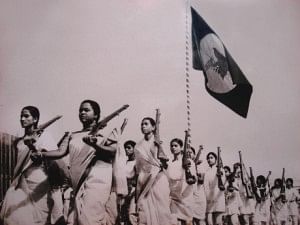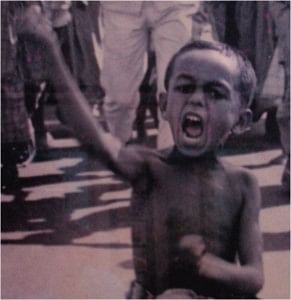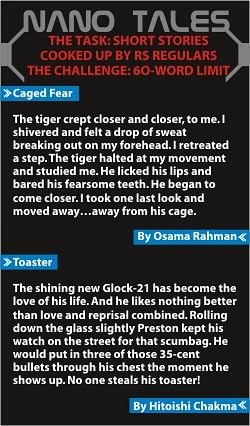
By Shuprova Tasneem & Adnan M. S. Fakir
While we have quite a few museums scattered all over our country, the true account of our Liberation War history is barely depicted in any; in 1995, eight prominent individuals took the initiative to fill this large gap and established the Liberation War Museum, located currently at 5 Segun Bagicha. It was certainly not an easy task to accomplish, and they had to personally travel to many remote corners of Bangladesh in search of genuine information and artifacts regarding the War. Though the Museum was initially set up with their own funds, an appeal to the country brought in donations from many different quarters, starting from large companies to schoolchildren saving their allowances!
 The Liberation War Museum has done an astonishing job by appropriately recounting all events that occurred in our history which lead to the creation of Bangladesh. Divided chronologically into six galleries, each gallery exhibits exclusive mind-blowing collections of photos, stories and facts about our war.
The Liberation War Museum has done an astonishing job by appropriately recounting all events that occurred in our history which lead to the creation of Bangladesh. Divided chronologically into six galleries, each gallery exhibits exclusive mind-blowing collections of photos, stories and facts about our war.
Hinduism and Buddhism were always intricate with Bengal until the emergence of the Muslim era in the 12th century and the Museum starts off with a brief display titled “Secular Bengal” with models of Paharpur, Shat Gombuj Masjid, Kantajir Temple and other historical monuments, giving adequate reasons for us being a secular nation. The display continues with a wall dedicated to great people in Bengal, starting from Rabindranath and Biddyashagor to Begum Rokeya and Kazi Najrul Islam. There is also a section dedicated to the dissent against foreign occupation during the British Colonial Period, giving us various details, from the Sepoy Mutiny and other rebellions organised against the British to even the names of those hanged in British prisons.
After the British era, the Partition of the large terrain into Pakistan and India is accentuated upon while the major exhibits are chronologically divided into the important occasions that occurred from the Partition in 1947 to the birth of Bangladesh in 1971. It tells us about the Language Movement in 1952, giving us extensive details of all those who were martyred for the sake of their mother tongue, including newspaper clippings and heart wrenching pictures of the bloodbath.
There is comprehensive information on the West's oppression on the East, the ban on Bengali cultural activities, the Agartala Conspiracy Case, the mass upsurge that followed in 1969, the struggle for democracy and national right, the first nation wide 1970 election which Sheikh Mujib unanimously won, the 1971 Non-Cooperation Movement, the “negotiations” that Yahya Khan pretended to hold, the role of great leaders such as Moulana Bhashani etc. Details are revealed for each incident, through leaflets, manuscripts, old newspapers, personal diaries, posters and also through individual incidents such as the pictures and belongings of a 13 year old boy killed by the Pakistanis while participating in a rally, a young woman who was shot while feeding her infant and many others. The terrible cyclone of 1970 is also portrayed with rare pictures of the decaying bodies washed ashore after the disaster, the devastation that followed and the Pakistani government's indifference towards the crisis.
Horrific footage of the genocide beginning from the night of 25th March, 1971 follows. The most striking part of this display was the pictures. There were photos of women hiding their faces and crying over the dead bodies of their sons, of countless bodies piled over each other and being eaten by scavengers; intellectuals butchered by the Razakars and a freedom fighter's infant, whose head was crushed by the boots of Pakistani soldiers.
There were other distressing pictures as well, of women raped and killed, the atrocious torture inflicted on captured freedom fighters including a separate section on the painful plight of the refugees who fled to India and lived under inhumane conditions. In the silent corners of the Liberation War Museum, these displays leap out from the walls and hit you in the heart, giving you a faint taste of the desolation and agony felt by those who suffered in the war.
 The Museum exhibits continue with the sector commanders who played important roles in the Liberation War, and also greatly stresses on the part played by the common people: notably the women, children, students, peasants and others who formed the backbone of the Mukti Bahini; as well as those who supported the cause in their own way and deserve to be remembered in our history. There are countless pictures of women protesting in the streets in 1952 and 1969, as well as records of many brave women who trained with weapons and fought in the Muktibahini, many of whom died during the War. Also, proper respect and recognition is paid to the women who were raped and killed, and others who were taken to the camps and forced to satisfy the lust of the Pakistani beasts.
The Museum exhibits continue with the sector commanders who played important roles in the Liberation War, and also greatly stresses on the part played by the common people: notably the women, children, students, peasants and others who formed the backbone of the Mukti Bahini; as well as those who supported the cause in their own way and deserve to be remembered in our history. There are countless pictures of women protesting in the streets in 1952 and 1969, as well as records of many brave women who trained with weapons and fought in the Muktibahini, many of whom died during the War. Also, proper respect and recognition is paid to the women who were raped and killed, and others who were taken to the camps and forced to satisfy the lust of the Pakistani beasts.
The excavated bones of the intellectuals who were coldly and systematically taken and slaughtered in the Mirpur Slaughterhouses is contained within the museum while it also clearly names the Razakars and others who collaborated with the enemies in this task, some of whom ironically were recently a part of our government! And finally, there are pictures of the surrender of East Pakistan, mementos of the Bir Sreshtos, and the elation by all who became part of a liberated Bangladesh!
The role of the media and the international view of the genocide in 1971 are also properly portrayed in the museum. It gives due credit to Indira Gandhi, Senator Edward Kennedy and other politicians in some European countries, UK, Japan, Soviet Union and Australia who supported our cause, and boldly states China's and Nixon's decision to ignore the genocide that occurred in Bangladesh and support Pakistan. The Museum acknowledges the non-resident Bangladeshis protests in foreign countries, the many journalists who stayed back in Bangladesh despite the war, and also BBC, Daily Telegraph (UK), Voice of America, German TV, All India Radio and Shadhin Bangla Betar Kendro. It also pays homage to many musicians, philosophers and poets who supported our cause, all of which contributed to spreading awareness and encouragement during the War.
As of May 2004, the Liberation War Museum has almost 11000 artifacts, although they are able to display only around 1300 because of lack of space. It regularly organizes school trips and cultural programmes to spread awareness among our generation and also houses a unique bookshop and research centre where one can learn more about the War. The Museum is planning to expand and include virtual tours with light and sound, and you can be of assistance by donating to the Museum or giving them any information or artifacts regarding the War which you think might be of value. For more information, please log on to www.liberationmuseum.org.bd which is, by the way, an amazing website and a must see. Most importantly do visit the museum and we guarantee you will learn a lot about our identity and the history of our struggles.

